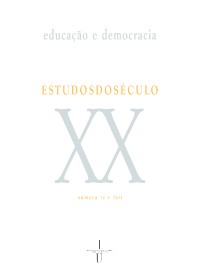Please use this identifier to cite or link to this item:
https://hdl.handle.net/10316.2/36826| Title: | Los derechos de la infancia y la construcción de la ciudadanía en América Latina | Other Titles: | Os direitos das crianças e a construção da cidadania na América Latina The children's rights and the construction of citizenship in Latin America Les droits des enfants et la construction de la citoyennete en Amerique Latine |
Authors: | Dávila, Paulí Naya, Luis Mª Altuna, Jon |
Keywords: | Children’s Rights;Human Rights;Right to Education;Latin America;Droits de l'enfant;Droits de l'homme;Droit à l'éducation;Amérique latine;Direitos das Crianças;Direitos Humanos;Direito à Educação;América Latina | Issue Date: | 2014 | Publisher: | Imprensa da Universidade de Coimbra | Abstract: | A construção da cidadania está
relacionada com os direitos humanos.
Neste campo, o reconhecimento
dos direitos das
crianças e dos adolescentes é
recente. A Convenção dos Direitos
da Criança (CDC) de
1989 demonstrou constituir
uma alteração no paradigma do
conceito de infância e no reconhecimento
das crianças enquanto
sujeitos de direito.
Neste contexto, todos os países
da América Latina ratificaram o
referido tratado internacional,
tendo sido efetuados, nos últimos
anos, avanços legislativos
importantes, para além da criação
de políticas públicas relativas
às crianças e focadas nos
direitos humanos.
O objetivo do presente artigo é
analisar o alcance destes direitos
tendo por base os relatórios
recebidos e elaborados pelo
Comité dos Direitos da Criança,
através dos quais o mesmo Comité
se faz pronunciar, fazendo
observações e dando recomendações.
A análise da documentação
produzida fornece informações
suficientes acerca da
situação das crianças na América
Latina.
Assim, centrar-nos-emos apenas
num dos direitos mais importantes:
o direito à educação, seguindo
o esquema dos quatro A
de Katarina Tomaševski. Através desta análise pretende-mos demonstrar
a relação entre os
pressupostos educativos e a
realidade da infância na América
Latina. La construction de la citoyenneté est liée aux droits de l'homme. La reconnaissance des droits des enfants et des adolescents est récente dans ce domaine. La Convention relative aux droits de l'enfant (CRC) 1989 a entraîné un changement de paradigme du concept de l'enfance et du respect de l'enfant en tant que sujet de droit. Dans ce contexte, tous les pays d'Amérique latine ont ratifié ce traité international. Des avancées législatives significatives ont eu lieu pendant les deux dernières décennies, ainsi que le développement de politiques publiques sur les enfants qui, en général, maintiennent une approche des droits de l'homme. Le but de cet article est d'analyser la portée de ces droits à travers les rapports reçus et produits par le Comité des droits de l'enfant. Le Comité prend des décisions à partir de ses observations et recommandations. L'analyse de la documentation produite fournit suffisamment d'informations sur la situation des enfants en Amérique latine. Nous allons nous concentrer sur l'un des droits les plus importants, le droit à l'éducation, en suivant le concept des 4-A de Katarina Tomasevski. Grâce à cette analyse, nous pouvons montrer la correspondance entre les budgets de l'éducation et la réalité des enfants en Amérique latine. The construction of citizenship is related to human rights. In this field the recognition of the rights of children and adolescents is recent. The Convention on the Rights of the Child (1989) has led to a paradigm change in the concept of childhood and the consideration of children as subjects of rights. In this context, all Latin American countries have ratified this international treaty, and in the last two decades, there have been significant legislative progress as well as development of public policies on children who generally maintain a human rights approach. The aim of this article is to analyse the extent of these rights through the reports that the Committee on the Rights of the Child receives and produces. The Committee answers through their observations and recom-mendations. The analysis of the generated documentation gives us enough information about the situation of the childhood in Latin America. We will focus on one of the most important rights: the right Through this analysis we will to education, employing Tomaševski’s 4As scheme. try to show the correspondence be- tween education budgets and the reality of children in Latin America. |
URI: | https://hdl.handle.net/10316.2/36826 | ISSN: | 1645-3530 1647-8622 (digital) |
DOI: | 10.14195/1647-8622_14_1 |
| Appears in Collections: | Revista Estudos do Século XX |
Files in This Item:
| File | Description | Size | Format | |
|---|---|---|---|---|
| los_derechos_de_la_infancia.pdf | 1.79 MB | Adobe PDF |  |
Items in DSpace are protected by copyright, with all rights reserved, unless otherwise indicated.
